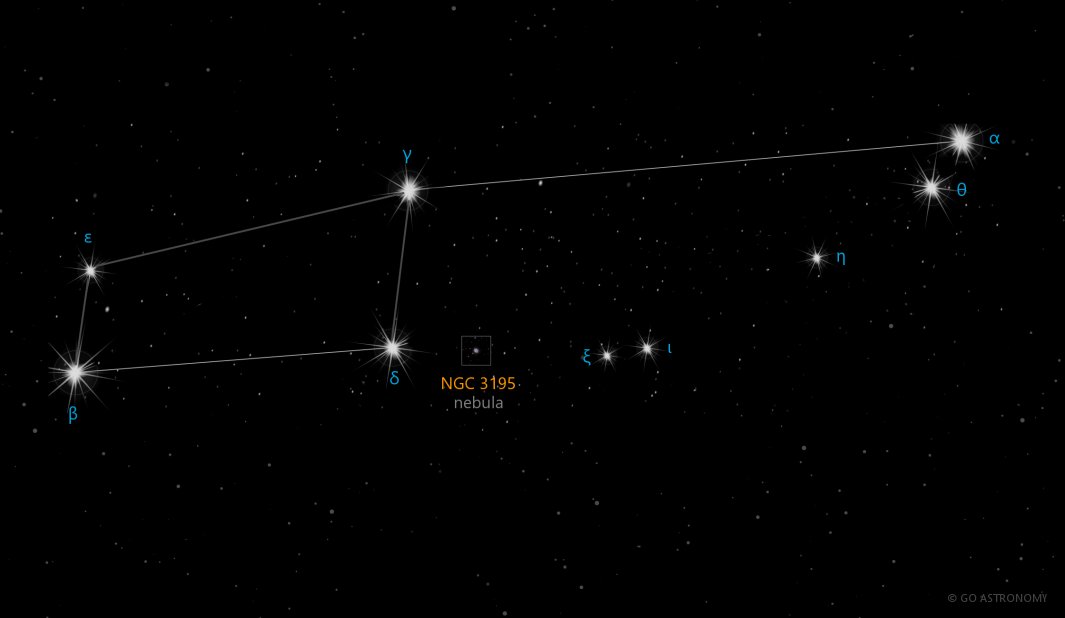Chamaeleon, the Chameleon (Cha)
(cuh-MEAL-yun)
The Southern constellation of Chamaeleon, the Chameleon, is best viewed in Spring during the month of April.
Chamaeleon is the 79th largest constellation. It's brightest star is Alpha Chamaeleontis at magnitude 4.05. The boundary of the Chamaeleon constellation contains 4 stars that host known exoplanets.
Chamaeleon is a circumpolar constellation, so is visible year-round in the Southern hemisphere. Conversely, it is not visible in the opposite hemisphere.
Gliese 65 (Luyten?726-8) is the 8th closest star to Earth at 8.8 light years.
- Pronunciation:
- cuh-MEAL-yun
- Meaning:
- Chameleon
- Genitive:
- Chamaeleontis
- Abbreviation:
- Cha
- Constellation Family:
- Bayer
- Hemisphere:
- Southern
- Quadrant:
- SQ2
- Visibility:
- 0° - 90° S
- Best viewing month*:
- April
- Area:
- 132 sq. degrees
- Size:
- 79th largest
- Circumpolar** (N=northern, S=southern):
- S circumpolar
- Right Ascension (avg):
- 12h 0m
- Declination (avg):
- -79°
- Brightest star:
- Alpha Chamaeleontis (4.05)
- Stars with planets:
- 4
- Messier objects:
- |
Brightest Stars in Chamaeleon
The 10 brightest stars in the constellation Chamaeleon by magnitude.
- Star
- Magnitude
- Spectral class
- Alpha Chamaeleontis (α Cha)
- 4.05
- F5III
- Gamma Chamaeleontis (γ Cha)
- 4.11
- M0III
- Beta Chamaeleontis (β Cha)
- 4.24
- B5Vn
- Theta Chamaeleontis (θ Cha)
- 4.34
- K0III-IV
- Delta Chamaeleontis (δ2 Cha)
- 4.45
- B2.5IV
- Epsilon Chamaeleontis (ε Cha)
- 4.88
- B9Vn
- Kappa Chamaeleontis (κ Cha)
- 5.04
- K4III
- Zeta Chamaeleontis (ζ Cha)
- 5.07
- B5V
- Iota Chamaeleontis (ι Cha)
- 5.34
- F3/F5IV
- Nu Chamaeleontis (ν Cha)
- 5.43
- G8III
Nebulae in Chamaeleon
Notable and easy-to-find nebulae in the constellation Chamaeleon. Also see all nebulae.
Galaxies in Chamaeleon
The most notable galaxies in the constellation Chamaeleon. Also see all galaxies.
A Lizard of the Southern Sky
The constellation of Chamaeleon, named after the color-changing lizard, is a small and faint constellation nestled in the deep southern skies. Unlike its vibrant namesake, Chamaeleon is understated and not well known. Yet, it holds a myriad of astronomical treasures and is an intriguing part of the cosmos for both astronomers and stargazers.
Historical Overview
Unlike many of the more recognized constellations, Chamaeleon doesn't hail from ancient Greek mythology. Instead, it was named in the 16th century by Dutch navigators Pieter Dirkszoon Keyser and Frederick de Houtman, who were tasked with charting the southern skies during the age of exploration. Their work was later included in the Uranometria, an atlas created by the German lawyer and astronomer Johann Bayer, and this is where Chamaeleon was formally introduced to western astronomy.
Location and Notable Features
Chamaeleon is located in the second quadrant of the southern hemisphere (SQ2) and can be seen at latitudes between +0? and -90?. It is surrounded by several constellations: Apus, Carina, Mensa, Musca, Octans, and Volans. Despite its relatively diminutive size?ranking 79th in size among the 88 constellations?it harbors several notable stars and deep sky objects.
The constellation doesn't have any stars brighter than magnitude 4.0. Its brightest star, Alpha Chamaeleontis, is a white-hued star of magnitude 4.07, located approximately 63.5 light years away from us. Beta Chamaeleontis is the second brightest star in this constellation, with a magnitude of 4.26.
Deep Sky Objects
While it doesn't host any Messier objects, Chamaeleon is home to several deep-sky objects. Most notable among these is the Chamaeleon complex, a large star-forming region that includes three dark clouds, known as Chamaeleon I, II, and III, which have spawned numerous young stars. Chamaeleon I is one of the nearest active star-forming regions to the Sun, making it an important subject of study for astronomers interested in the processes of star birth and early stellar evolution.
The constellation is also home to the Eta Chamaeleontis cluster, an open cluster of approximately twelve stars that are bound together by gravity. This cluster is relatively young, estimated to be about eight million years old.
Observing Chamaeleon
Chamaeleon's stars are not particularly bright, and the constellation itself is relatively small and faint. Therefore, it is best seen from the southern hemisphere during the autumn months. Observers in the northern hemisphere, particularly those at higher latitudes, may find it difficult to see Chamaeleon as it never rises high above the horizon.
To find it, one should look towards the southern sky, in the vicinity of the Southern Cross, a prominent constellation that can serve as a marker. Observers will need a clear, dark sky and, for observing deep-sky objects within the constellation, a small telescope would be useful.
* Constellation shown for northen hemisphere skies. For the southern hemisphere, constellations appear rotated 180 degrees (upside-down and left-right reversed) from what is shown. Remember that seasons are reversed too - summer in northern latitudes is winter in southern latitudes.
** Circumpolar constellations are visible year-round in the hemisphere listed (and not at all in the opposite hemisphere).





